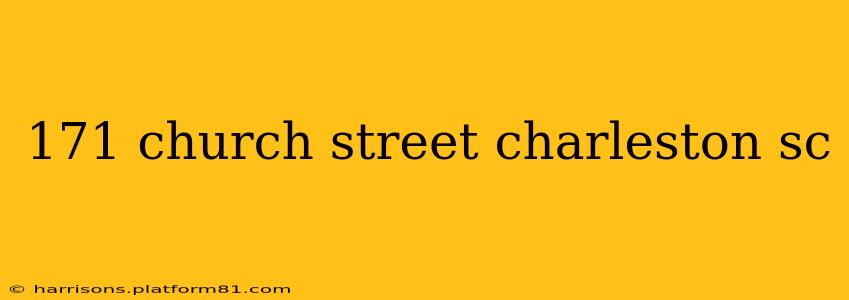171 Church Street, Charleston, SC: Unveiling the History and Charm of a Historic Address
171 Church Street in Charleston, South Carolina, isn't just an address; it's a portal to the city's rich history and architectural beauty. This location, nestled within the heart of Charleston's historic district, holds a unique place in the city's narrative. While specific details about the current building and its inhabitants are often private, exploring the neighborhood and the general history of structures in this area reveals a fascinating story.
This post will delve into the historical context of 171 Church Street, exploring the architectural styles prevalent in the area, the likely history of the building (given its location and age), and answering frequently asked questions surrounding historic Charleston addresses.
What is the history of the buildings on Church Street in Charleston?
Church Street itself boasts a fascinating history, reflecting the evolution of Charleston from its colonial roots to its modern-day charm. The street's name speaks to its early significance – likely associated with a church or religious institution in the area. Many buildings along Church Street, including those likely near 171, date back to the 18th and 19th centuries, showcasing a variety of architectural styles common in Charleston’s historic district. These include:
- Single houses: These are narrow, single-family homes, often two to three stories tall, characteristic of the colonial and antebellum periods.
- Double houses: These are essentially two houses joined together, sharing a common wall. They were often built to maximize space in the densely populated areas.
- Georgian architecture: Characterized by symmetry, classical details, and often featuring a grand central entrance.
- Federal architecture: This style, popular in the late 18th and early 19th centuries, features elegant proportions, decorative moldings, and often fanlights above the doors.
- Greek Revival architecture: With its emphasis on classical Greek forms and details, this style also influenced many structures in the area.
The specific architectural style of the building at 171 Church Street would require a property records search or a visit to the Charleston County Public Library's local history collection. However, given the location, it is highly probable that the building reflects one or a combination of these styles.
What kind of homes are on Church Street?
The homes on Church Street are primarily historic residences, reflecting Charleston's unique architectural heritage. They tend to be relatively narrow, reflecting the density of the historic district, and are often multi-storied. Many have been meticulously preserved and restored, maintaining their original character while incorporating modern amenities.
Is 171 Church Street a historic landmark?
Whether 171 Church Street is officially designated a historic landmark would need to be verified through official Charleston city records. Many buildings in this area are located within designated historic districts, which offer protection and guidelines for preservation. However, individual landmark status requires specific designation.
How can I find more information about 171 Church Street?
For detailed information about the property at 171 Church Street, you could try the following:
- Charleston County Property Records: This is the best resource for information such as ownership and tax assessment data, which may give clues about the building's history.
- Charleston County Public Library: Their local history collection might contain records and photographs related to the address.
- Charleston Historic Preservation Society: This organization may possess information on the building or the architectural history of the area.
While specifics about the current state and history of 171 Church Street remain elusive without deeper research, the broader context reveals the captivating historical significance of this address within the rich tapestry of Charleston's past. The charm and history of the surrounding neighborhood provide a strong indication of the likely story held within the walls of 171 Church Street.
